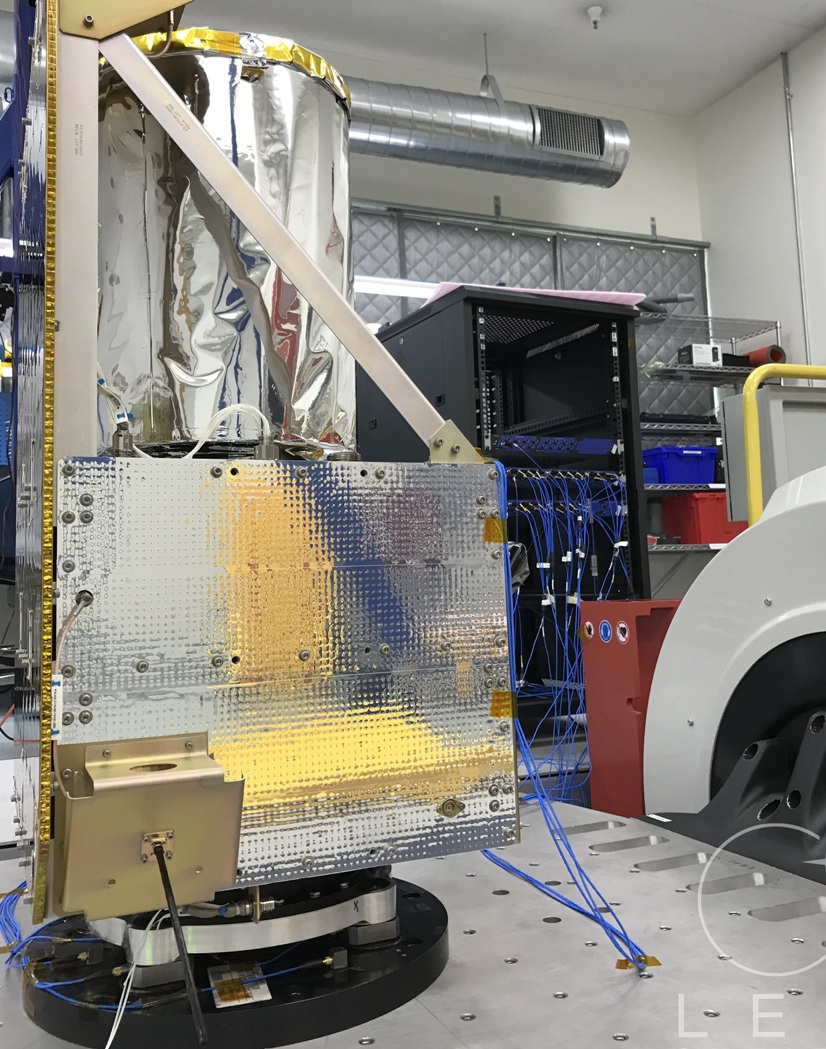Satellite manufacturer uses force limited vibration testing on its products using closed loop vibration table control software
Seattle based microsatellite manufacturer, LeoStella is applying force limited vibration testing (FLVT) to its satellite testing processes as part of the company’s focus on having scalable and cost-efficient production processes.
Safe Satellite Tests with FLVT
The purpose of the testing that LeoStella carries out is to check whether the satellites can withstand the stresses of a rocket launch and operation. It does this using both sinusoidal and random excitation generated by m+p VibControl software and supplied to the vibration table shaker via the m+p VibRunner data acquisition hardware. Measurement of acceleration and forces by sensors and monitoring by m+p VibControl closes the control loop and allows for accurate, fast and safe control of the desired vibration amplitude. The definition of the tests is easy to follow and adaptable for efficient programming.
To meet the highest safety demands, LeoStella uses the Vector Notching option of m+p VibControl. Notching enables the targeted adjustment of the excitation amplitude depending on the vibrations seen by the satellite. Whenever resonances appear, the excitation is reduced in a targeted and fully automatic manner, in order to avoid damage.
m+p VibControl eliminates the need for external, analogue and error-prone summation of sensor signals during 3D vibration tests. The Vector Notching option handles vibration monitoring in all three dimensions, providing maximum protection against over-testing and immediate detection of sensor failures.
Flexible Measurement Hardware for the Test Lab
m+p international data acquisition hardware is tailored to the requirements of tests on microsatellites such as at LeoStella: The system consists of three m+p VibRunner data acquisition systems synchronised with each other via clock in/clock out circuitry, providing a total of 56 input channels and two output channels. Due to the modular design of the m+p data acquisition hardware, almost any combination of the number of output and input channels can be realised – up to several thousand channels. The accurate and reliable measurement performance is also not influenced by the number of channels.
Extensive Shock Testing of Satellites
LeoStella also uses the integrated m+p VibControl shock testing modules. From the launch of a rocket to the deployment of the satellite, a large number of short loads with very high acceleration amplitudes occur (up to 200,000g). m+p VibControl simulates the shocks exactly in the test laboratory. LeoStella can therefore optimise the design of the satellites to withstand the loads during the rocket launch even in the early development phase and therefore avoid damage.
m+p VibControl offers a wide range of options for recording and processing time data from shocks. With Transient Capture you can record arbitrary shocks. You can either use them directly with m+p VibControl to control a shaker or convert them to a Shock Response Spectrum (SRS).
The interaction of the m+p VibControl vibration control software and the m+p VibRunner or m+p VibPilot data acquisition hardware enables maximum flexibility and efficient test definition and execution.
Maximum Data Control with Throughput
Using the m+p VibControl Throughput option, LeoStella can easily perform all measurement tasks with a single system. All the acquired time data is saved directly to the PC’s hard disk and can be further processed as required. This eliminates the need for a separate data acquisition system.
The uniform file format allows all m+p software products to be used for data evaluation. For example, m+p Analyzer can be used to display the operating deflection shapes (ODS) in an animation and calculate the structural dynamic transfer functions. With m+p VibControl, the data can also be exported into universally usable data formats.
- UK manufacturing steps up to COVID-19 crisis - April 2, 2020
- Clustering Innovation - March 12, 2020
- A Global Monitor - March 6, 2020

